| |
Startling
2000 year old inscription proves the Resurrection of
Christ,
and disproves the myth of Saint Peter at Rome!! |
|
The
Nazareth Inscription is a 24" x 15" marble tablet with a 14-line
"Edict of Caesar" prescribing capital punishment for body
stealing, acquired by Wilhelm Fröhner (1834–1925), Paris, in 1878, sent
from Nazareth. Since 1925 it has been in the Bibliothèque nationale,
Paris, displayed in the Cabinet des Médailles.( Wikipedia article, Nazareth
Inscription).
The
Fröhner Collection was acquired by the Paris National Library in 1925,
and a Russian archeologist named M. Rostovtzeff brought it to the attention
of a French archeologist named M. Franz Cumont, who translated the inscription
into French. Subsequently, it was translated into English and created
a firestorm in the academic world.
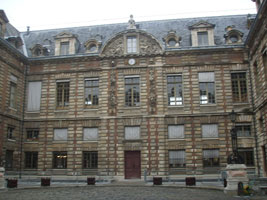
La Bibliothèque nationale,
58 rue de Richelieu. |
| |
This
2000 year old stele is a decree
of Caesar against tomb robbing or body stealing.
Hurry
and see it before it disappears.
Tomb
robbing was the very charge leveled against Simon Peter
and the other Apostles of Christ to explain away the Resurrection.
|
|
|
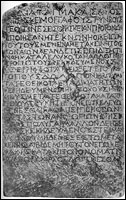
The Nazareth Inscription. |
Only
a few scholars in the academic world are familiar with this extraordinary
tablet. Here is an English translation of the tablet:
An
edict of Caesar. It pleases me that graves and tombs, whoever has
made them as a religious act for forebears or children or household
members, that these remain undisturbed forever. But if any should
show that someone has either destroyed or in any other way cast out
those buried there, or has with evil deception removed them to other
places, an injustice for those buried there, or has removed the monument
or the stones, in such a case I command that there be a trial, as
if pertaining to matters of the gods, for the benefit of the religious
duty of men. For it shall very much be required to honor those who
have been buried. Let no one move them for any cause.
But if someone does not comply, it is my will that he suffer capital
punishment on a charge of robbing tombs.
Most
reliable scholars say that the Caesar in question was Emperor Claudius,
and date it to around 41 A.D. The edict required the death
penalty for robbing tombs. Pagan Romans usually cremated their dead
so it is amazing that the Emperor was concerned about grave robbers.
The
Nazarenes were accused of tomb robbing!!
The
Messiah rose from the dead on the Mount of Olives overlooking Jerusalem.
The followers of the Messiah were called Nazarenes.
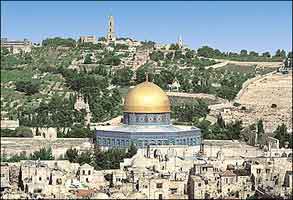 Mount
of Olives overlooking Jerusalem. Mount
of Olives overlooking Jerusalem.
|
|
The
Mount of Olives was the location of the Resurrection of
Joshua of Nazareth.
Immediately
after the Resurrection, the Pharisees accused Peter and
the other disciples of breaking into the tomb and stealing
his body.
|
|
|
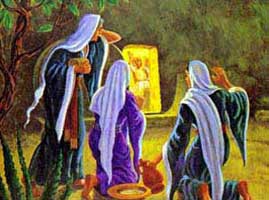
"He is
not here but is risen"
(Luke 24:6).
|
Here
is one of four surviving accounts of the dramatic events on the Resurrection
morning:
In
the end of the sabbaths, as it began to dawn toward the first of the
sabbaths, Miriam of Magdala and the other Miriam came to see the tomb.
And, behold, there was a great earthquake: for the angel of the Lord
descended from heaven, and came and rolled back the stone from the
door, and sat upon it. His countenance was like lightning, and his
raiment white as snow: And for fear of him the guard did shake, and
became as dead men(Matthew 28:1-4).
This
guard was a sentry of Roman soldiers that Pontius Pilate commanded to
guard the tomb. When the soldiers recovered their senses, they went
into the city and reported to the chief priests all that had happened:
Now
when they were going, behold, some of the guard came into the city,
and showed the chief priests all the things that were done. And when
they were assembled with the elders, and had taken counsel, they gave
a large sum of money to the soldiers, Saying, Say ye, His disciples
came by night, and stole him away while we slept.
And if this comes to the governor's ears, we will persuade him, and
secure you. So they took the money, and did as they were taught: and
this saying is commonly reported among the Jews until this day
(Matthew 28:11-15).
Pilate
heard of the Resurrection almost immediately after it happened so he
and the soldiers must have received huge bribes to maintain the tomb
robber myth.
The
Messiah remained with his disciples for 40 days after his Resurrection:
To
whom also he showed himself alive after his passion by
many infallible proofs, being seen of them forty days, and
speaking of the things pertaining to the kingdom of God
(Acts 1:3).
After
his ascension into Heaven to sit at the right hand of JEHOVAH, the first
order of business for the Messiah was to kick Satan and his fallen angels
right out of heaven:
And
there was war in heaven: Michael and his angels fought against the
dragon; and the dragon fought and his angels,
And prevailed not; neither was their place found any more in
heaven. And the great dragon was cast out, that old serpent, called
the Devil, and Satan, which deceiveth the whole world: he was cast
out into the earth, and his angels were cast out with him(Revelation
12: 7-9).
The expulsion of
Satan meant the cleansing of heaven from his defiling footprints, but
it was very, very bad news for planet earth:
Therefore
rejoice, ye heavens, and ye that dwell in them. Woe to the inhabiters
of the earth and of the sea! for the devil is come down unto you,
having great wrath, because he knoweth that he hath but a short time
(Revelation 12:12).
After
his expulsion from heaven, Satan took total possession of Pontifex Maximus
Caligula . . . and all the Pontiffs that succeeded him!!
Satan
took total possession of Emperor Caligula!!
At
the time of the Resurrection, Tiberius was Emperor, but he was in self
imposed exile on the Isle of Capri, and given over to ever kind of perversion
and debauchery.
He
was succeeded in 37 AD by Gaius Julius Caesar Augustus Germanicus, commonly
known as Caligula "little boots."
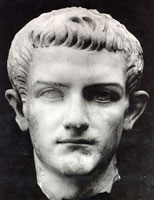
Emperor Caligula (12–41 AD).
Emperor from 37 to 41 AD. |
| |
The
mad Pontiff Caligula was the adopted son of Tiberius.
He became Emperor with the help of the standing army Praetorian
Guard.
About
6 months into his reign, he became totally Satan possessed
and he called himself Zeus
and his sister/wife Druscilla he called
Hera. |
|
|
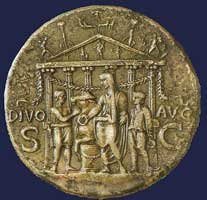
Pontiff Caligula sacrificing at the
temple of Jupiter. |
Caligula
called himself Zeus and demanded divine worship from everyone in the
Empire. He was determined to put his statue in the Great Temple in Jerusalem:
Now
Caius Caesar did so grossly abuse the fortune he had arrived at, as
to take himself to be a god, and to desire to be so called also, and
to cut off those of the greatest nobility out of his country. He also
extended his impiety as far as the Jews. Accordingly he sent Petronius
with an army to Jerusalem to place his statues in the temple, and
commanded him that, in case the Jews would not admit of them, he should
slay those that opposed it, and carry all the rest into captivity.
(Josephus, Wars
of the Jews, Book II, 10,1).
Only
the timely assassination of the mad Caligula prevented him from forcing
everyone in the Empire to worship him as Zeus incarnate.
In
41 AD his infamous career was cut short by assassins . . . and that
was the end of the first line of Satan possessed Pontiffs.
Emperor
Claudius issued the tomb robbing decree
The
next Pontiff to succeed him was Tiberius Claudius Caesar Augustus Germanicus,
commonly known as Emperor Claudius. He was placed in power directly
by the standing army called the Praetorian Guard. In
43 AD he added Britannia to the Roman Empire.
Claudius
grew up with Herod Agrippa in Rome and the two of them were very, very
close friends. Claudius survived all the poisonings because he stammered
and had several physical handicaps so nobody believed that he would
ever become Emperor. He was a prolific writer however and wrote a detailed
history of his family in forty-three volumes . . . which did not survive
. . . unless in the Secret Archives of the Vatican!!
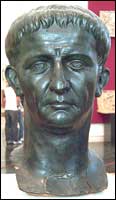
Emperor Claudius (10 BC - 54 AD).
Emperor from 41 to 54 AD. |
| |
Emperor
Claudius was the 2nd of the Satan possessed Pontiffs.
Claudius
and Herod Agrippa grew up together in Rome.
At
the instigation of Herod, Claudius issued the tomb robbing
decree about 41 AD.
|
|
|
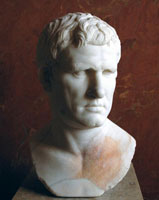
Herod Agrippa I (10 BC– 44 AD.
King from 41 to 44 AD. |
Herod
Agrippa received the kingdom of Judea from Emperor Claudius:
Now
when Claudius had taken out of the way all those soldiers whom he
suspected, which he did immediately, he published an edict, and therein
confirmed that kingdom to Agrippa which Caius had given him, and therein
commended the king highly. He also made all addition to it of all
that country over which Herod, who was his grandfather, had reigned,
that is, Judea and Samaria; and this he restored to him as due to
his family. (Josephus, Antiquities,
XIX, 5,1).
Claudius
rescinded the previous persecuting decree of Caligula regarding the
Jews, and he issued a decree that was engraven
in stones that they should not be molested in the practice of
their religion:
And
I do charge them also to use this my kindness to them with moderation,
and not to show a contempt of the superstitious observances of other
nations, but to keep their own laws only. And
I will that this decree of mine be engraven on tables by the
magistrates of the cities, and colonies, and municipal places, both
those within Italy and those without it, both kings and governors,
by the means of the ambassadors, and to have them exposed to the public
for full thirty days, in such a place whence it may plainly be read
from the ground. (Josephus, Antiquities,
XIX, 5, 3).
At
that time it was a common practice that decrees of Caesar be engraven
in stone and displayed in a very prominent place so that all
could read them.
Herod
Agrippa believed that he was the Messiah!!
The
corrupt Herod actually believed that he was the Messiah. He
soon commenced a persecution of the followers of the real Messiah
at Jerusalem:
Now
about that time Herod the king stretched forth his hands to vex certain
of the congregation. And he killed James the
brother of John with the sword. And because he saw it pleased
the Jews, he proceeded further to take Peter
also. (These were the days of unleavened bread). And when he
had apprehended him, he put him in prison, and delivered him to four
squads of soldiers to keep him; intending after Passover to bring
him forth to the people. (Acts 12:1-4).
St.
Peter had a miraculous escape from the prison, and was delivered from
the murderous bloody hands of Herod Agrippa:
And
when Herod would have brought him forth, the same night Peter was
sleeping between two soldiers, bound with two chains: and the guards
before the door kept the prison. And, behold, the angel of JEHOVAH
came upon him, and a light shined in the prison: and he smote Peter
on the side, and raised him up, saying, Arise up quickly. And his
chains fell off from his hands. And the angel said unto him, Gird
thyself, and bind on thy sandals. And so he did. And he saith unto
him, Cast thy garment about thee, and follow me. And he went out,
and followed him; and did not know that it was true which was done
by the angel; but thought he saw a vision. When they were past the
first and the second ward, they came unto the iron gate that leadeth
unto the city; which opened to them of its own accord: and they went
out, and passed on through one street; and forthwith the angel departed
from him. And when Peter was come to himself, he said, Now I know
of a surety, that JEHOVAH hath sent his angel, and hath delivered
me out of the hand of Herod, and from all the expectation of the people
of the Jews. (Acts 12:6-11).
After
Peter's miraculous escape, Herod Agrippa wrote to his friend Claudius
and urged him to enact the death penalty for tomb robbing.
St.
Peter went to another place after
his escape from Herod!!
After
his miraculous escape from prison, Saint Peter visited his fellow believers
in Jerusalem:
And
as Peter knocked at the door of the gate, a damsel came to hearken,
named Rhoda. And when she knew Peter's voice, she opened not the gate
for gladness, but ran in, and told how Peter stood before the gate.
And they said unto her, Thou art mad. But she constantly affirmed
that it was even so. Then said they, It is his angel. But Peter continued
knocking: and when they had opened the door, and saw him, they were
astonished. But he, beckoning unto them with the hand to hold their
peace, declared unto them how JEHOVAH had brought him out of the prison.
And he said, Go show these things unto James, and to the brethren.
And he departed, and went into another place
(Acts 12:13-17).
St.
Peter did not go to Rome after his miraculous escape because Claudius
had enacted the death penalty for tomb robbing. Of course St. Peter
did not rob any tomb, but that did not matter to the Satan possessed
Claudius and Herod.
Divine
vengeance overtook Herod Agrippa a short time later, when he was eaten
alive by worms, as documented by the Book of Acts and Josephus:
And
upon a set day Herod, arrayed in royal apparel, sat upon his throne,
and made an oration unto them. And the people gave a shout, saying,
It is the voice of a god, and not of a man. And immediately the angel
of JEHOVAH smote him, because he gave not God the glory: and he was
eaten of worms, and died. (Acts 12: 21-23, Antiquities,
XIX, 8,2).
If
Saint Peter did go to Rome, he went incognito, and kept very,
very quiet about the fact that he was the leader of the Apostles of
Christ. Knowing how much Saint Peter liked to talk, that must have been
very, very hard for him to keep quiet about the Resurrection of the
Messiah and the empty tomb on the Mount of Olives.
No
difference between pagan and Papal Pontiffs
There
is no difference between the pagan and Papal Pontiffs. One wild beast
is used to symbolize Rome pagan and Papal:
After
this I saw in the night visions, and behold a fourth beast, dreadful
and terrible, and strong exceedingly; and it had great iron teeth:
it devoured and brake in pieces, and stamped the residue with
the feet of it: and it was diverse from all the beasts that
were before it; and it had ten horns. (Daniel 7:7).
Pagan
Pontiffs existed before Caligula, but he was the first Pontiff to be
completely controlled by Satan after he was cast out of heaven (Revelation
Chapter 12).
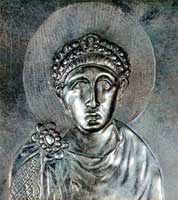
Mad Emperor Theodosius I (347–395).
Emperor from 378 to 392. |
| |
Mad
Emperor Theodosius was the last pagan Pontiff and Pope Damasus
I was the first Papal Pontiff.
Pontifical
succession can be traced back in an unbroken line 2000 years
to Emperor Caligula.
It
is the oldest dynasty in the world. |
|
|
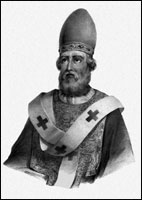
Pope Damasus I (305–384).
Pope from 366 to 384. |
St.
Paul said that something was restraining the Man of Sin and that restraint
would be removed. When Constantinople became the new capital of the
Empire, the bishop of Rome jumped right in to the vacant seat of the
pagan Pontiff:
For
the mystery of iniquity doth already
work: only he who now restrains will restrain, until he be taken out
of the way. And then shall that Wicked be revealed, whom the Lord
shall consume with the spirit of his mouth, and shall destroy with
the brightness of his coming
(II Thessalonians 2:1-12).
There
was no mystery or deception about Caligula, Claudius or Nero as the
Pontiffs or high priests of paganism persecuting Christianity, but a
so-called "Christian" bishop as a persecuting Pontiff is a
real mystery indeed.
The
pagan Egyptian obelisk is a sun worship phallic symbol and it was brought
from Egypt by the mad Pontiff Caligula.
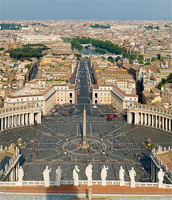
The Vatican obelisk was brought
fromEgypt to Rome by Caligula. |
| |
The
pagan Pontiffs called themselves vicars of Zeus or Jupiter.
When
the Papal Pontiff says "I am Peter" he means I
am Jupiter.
The
Papal Pontiffs also call themselves vicars of "Christ." |
|
|
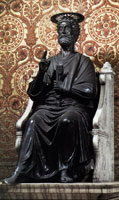
Statue of Jupiter in the Vatican
sans his trademark long hair!! |
Both
dynasties of Pontiffs claimed divine honors as "gods" on earth
Around
330 A.D., Jupiter was given a haircut
and renamed Saint Peter. Jerome's Latin
Vulgate changed Joshua to Jesus which is pronounced Gee-ZEUS in English
and Hey-Zeus in Spanish. Jerome also
translated the pagan word pontiff as priest 10 times
in the Gospel of John:
And
this he spoke not of himself: but being the high priest (pontiff)
of that year, he prophesied that Jesus should die for the nation
(John 11:51, Latin Vulgate Version).
Here
is that same verse from the Latin Vulgate:
hoc
autem a semet ipso non dixit sed cum esset pontifex
anni illius prophetavit quia Iesus moriturus
erat pro gente. (Latin Vulgate Version).
And
so everyone must decide whether they will follow the Papal Pontiff to
perdition . . . or the Risen Messiah . . . Joshua of Nazareth . . .
to eternal happiness in heaven.
References
Charlesworth,
M. P., Documents Relating to the Reigns of Claudius and Nero.
Cambridge University Press, 1939.
Graves,
Robert.
I, Claudius. Random House, New York, 1989.
Graves,
Robert.
Claudius the God and his Wife Messalina.
Random House, New York, 1989.
Jackson,
Douglas,
Claudius, Corgi Books, New York, 2010.
Peddie,
John. Conquest: The Roman Invasion of Britain. Alan Sutton
Publishing, Gloucestershire, UK, 1987.
Suetonius.
The
Twelve Caesars. (Translated by Robert Graves), Penguin Books,
London, 1957.
Josephus,
Flavius, Complete Works, translated by William Whiston. Kregel
Publication, Grand Rapids, Michigan, 1960.
Both
of the books by Robert Graves were made into a fantastic 12 part series
by the BBC in 1976. Entitled
I, Claudius, they are now available on utube.
Copyright
© 2013 by Patrick Scrivener
Back
to Main Menu
| 










